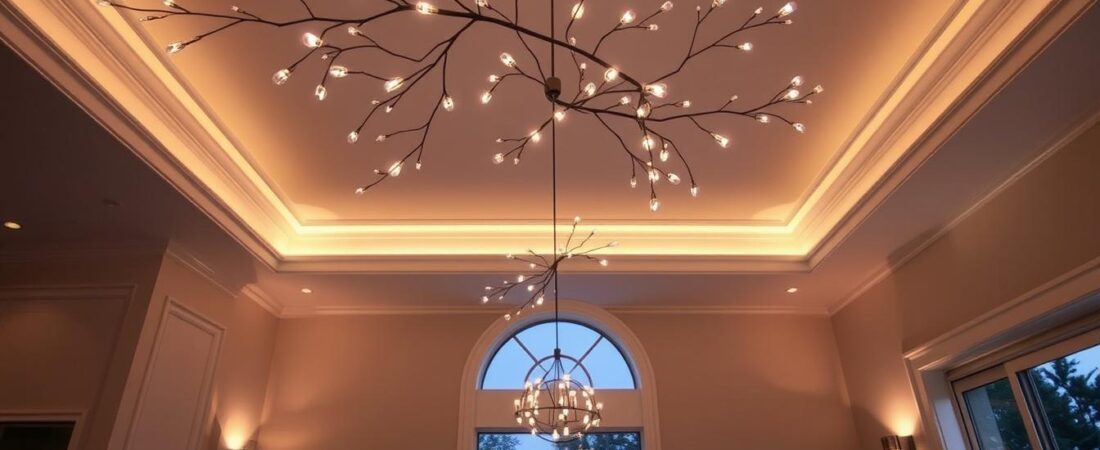Welcome to the world of smart lighting. Here, innovation meets style, turning your home into a cozy and elegant space.
An elegant lighting system can make your home look better and work better. With smart lighting, your home becomes more comfortable and easy to use.
Adding smart lighting to your home changes the mood and makes it feel welcoming. It’s a smart way to make your life better and more fun.
Key Takeaways
- Smart lighting combines innovation and style to enhance your home.
- An elegant lighting system elevates your living space.
- Smart lighting provides a more comfortable and convenient living experience.
- It enhances the ambiance and creates a welcoming atmosphere.
- Smart lighting is designed to make your life easier and more enjoyable.
Understanding Smart Lighting Systems
Smart lighting is changing how we light our homes. It makes lighting more efficient, convenient, and tailored to our needs. This technology offers benefits that old lighting can’t match.
What Makes Lighting “Smart”
So, what makes lighting “smart”? It’s the use of intelligent bulbs and sensors. These work together for a technology-driven illumination system. They let us control lights from afar, adjust them automatically, and track energy use.
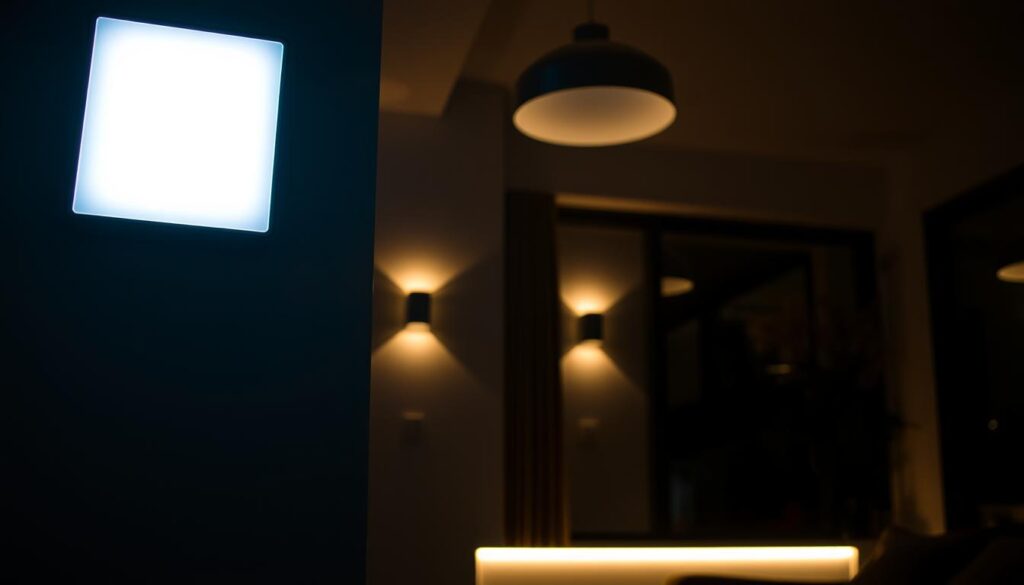
Key Components of Smart Lighting Systems
The main parts of smart lighting systems are:
- Smart Bulbs: These are LED bulbs that can be controlled via smartphone apps or voice assistants.
- Sensors: Motion and light sensors that adjust lighting based on occupancy and light levels.
- Controllers: Hubs or bridges that connect devices to the home network, allowing remote control.
Benefits of Upgrading to Smart Lighting
Smart lighting brings many advantages. It boosts energy efficiency, enhances ambiance, and adds convenience. It makes our homes more comfortable and welcoming. It also improves security by turning lights on and off when we’re away.
Knowing about smart lighting’s parts and perks helps homeowners choose the right upgrade. This leads to a more modern, efficient, and convenient home.
Smart Lighting: Technology Meets Elegance
Smart lighting systems are changing home lighting. They mix function with beauty. Home lighting has grown from simple to smart, improving both looks and use.
The Evolution of Home Lighting
Home lighting has changed a lot. We’ve moved from old bulbs to LED lights. Smart home lighting has taken it further, making control easy and flexible.
People want smart lighting for its ease, saving energy, and looks. It lets them change lights to match any mood or event.
How Technology Enhances Aesthetic Appeal
Technology boosts home lighting’s beauty. Automated lighting lets us control scenes easily. For example, it can mimic a sunset or adjust for the day.
| Feature | Benefit | Impact on Aesthetic Appeal |
|---|---|---|
| Color Temperature Control | Adjusts lighting color from warm to cool | Enhances ambiance and mood |
| Dimming Capability | Allows for adjustable brightness | Creates versatile lighting scenes |
| Scene Programming | Enables customized lighting scenes | Tailors lighting to specific activities or moods |
Creating Ambiance Through Intelligent Design
Smart lighting uses intelligent design. It lets us make unique atmospheres with scenes and schedules. It works well with other smart devices for a full experience.
For instance, it can work with entertainment systems for better viewing. It can also change with the weather, making homes cozy on rainy days.
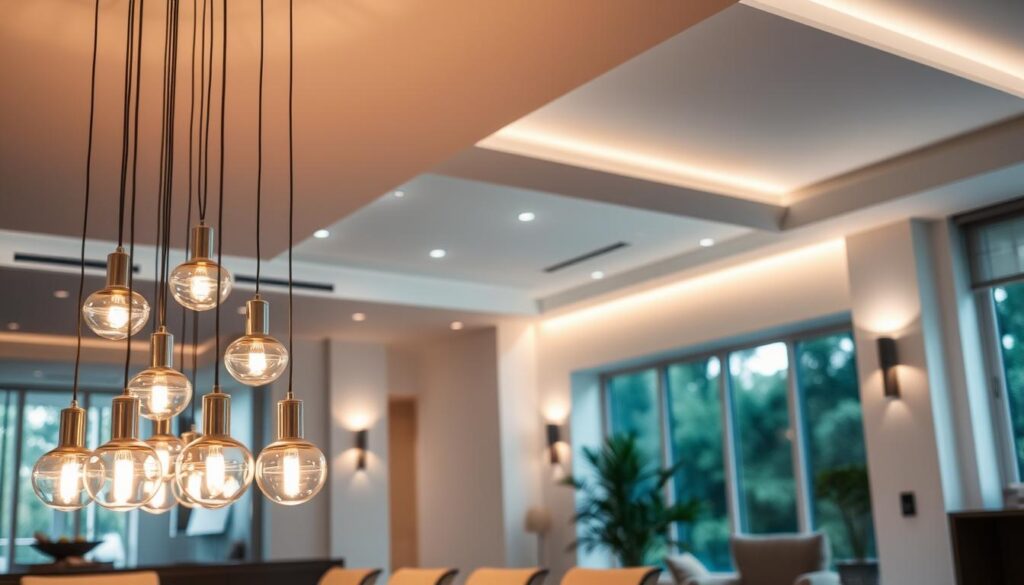
Smart lighting makes homes look better and saves energy. It’s a win-win for homeowners.
Types of Smart Lighting Products
Smart lighting technology has grown to include many products, from bulbs to fixtures. It improves home ambiance and efficiency. Homeowners can pick the best for their needs, whether for looks, function, or saving energy.
Smart Bulbs
Smart bulbs are a simple way to start with smart lighting. They fit into existing fixtures, making them affordable. Brands like Philips Hue and LIFX offer bulbs that can be controlled through apps or voice assistants.
Key Features: Color changing, dimming, scheduling, and energy monitoring.
Smart Switches and Dimmers
Smart switches and dimmers replace old wall switches. They let you control your home’s lighting. You can set them to turn lights on or off at specific times or conditions.
Benefits: Better control, energy savings, and works with other smart devices.
Smart Light Strips and Accent Lighting
Smart light strips are versatile for accent lighting, under-cabinet lighting, or TV backlights. They add ambiance to any room.
Popular Uses: Decorative lighting, task lighting, and immersive environments.
Smart Fixtures and Lamps
Smart fixtures and lamps work well with smart lighting systems. They offer features like scheduling and remote control. They come in various styles to match different decor.
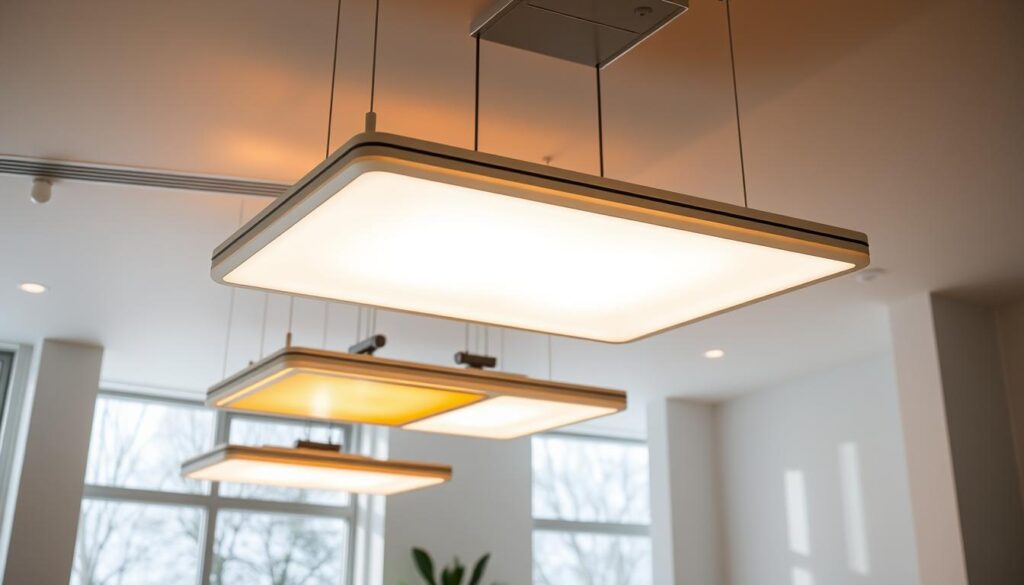
| Product Type | Key Features | Benefits |
|---|---|---|
| Smart Bulbs | Color changing, dimming | Easy to install, energy efficient |
| Smart Switches | Programmable, voice control | Convenient, integrates with smart home systems |
| Smart Light Strips | Flexible, color changing | Versatile, decorative |
| Smart Fixtures | Scheduling, remote control | Advanced control, stylish designs |
Selecting the Right Smart Lighting for Different Spaces
Choosing the right smart lighting for each area of your home is key. Each space has its own lighting needs. Smart lighting can meet these needs well.
When setting up your smart home, think about what each room needs. Things like mood, task lighting, and saving energy are important. They help pick the best smart lighting.
Living Room Lighting Solutions
The living room is where families and friends spend time. Smart lighting can make it cozy for relaxing or fun. Use smart bulbs or light strips to set the mood. Adjust the light and color for TV or reading.
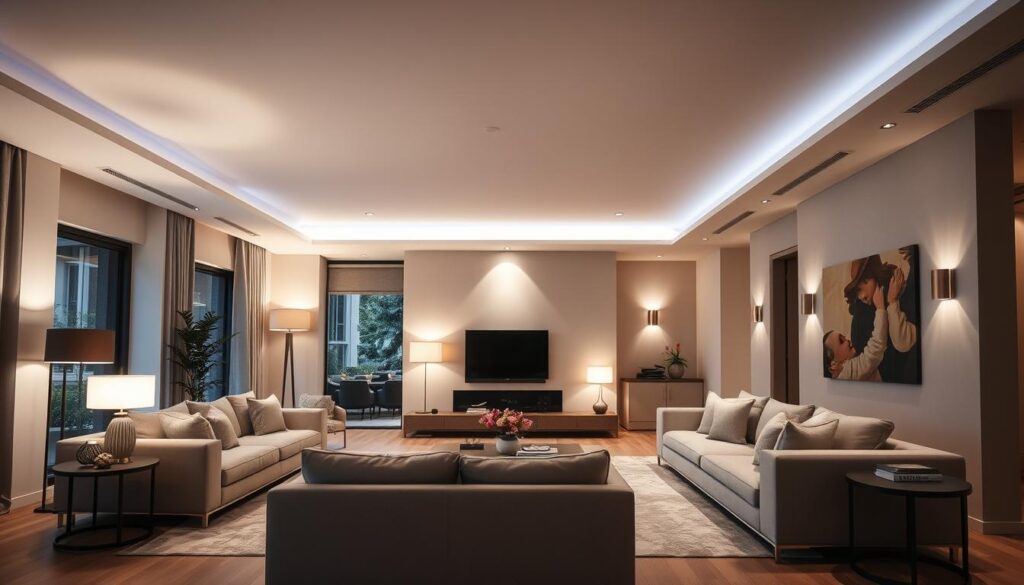
For a fancy setup, link smart lighting with your home theater. Or use voice commands to control the lights.
Bedroom Smart Lighting for Comfort
In the bedroom, smart lighting helps you relax. Warm white lighting is calming. Smart bulbs with adjustable brightness help you get ready for bed. Smart switches or dimmers make it easy to control the light.
Some systems have “goodnight” modes. They slowly dim the lights to signal bedtime.
Kitchen and Dining Area Illumination
The kitchen and dining need bright, inviting light. Smart lighting works well for cooking and dining. Under-cabinet lights and smart strips are great here.
Smart controls let you change light levels and colors. This fits different tasks and moods.
Outdoor Smart Lighting Options
Outdoor smart lights boost your home’s look and security. Smart outdoor lights turn on and off as needed. They keep intruders away and look good.
Think about smart LED floodlights or pathway lights. They light up your garden, driveway, or walkways.
Choosing the right smart lighting for each space makes your home better. It’s more comfortable, efficient, and fun.
Step-by-Step Installation Guide
Installing smart lighting is a process with several key steps. It ensures a smooth and efficient experience. Whether you’re upgrading or installing a new system, these steps will help you achieve technology-driven illumination. This will enhance your home’s ambiance and functionality.
Preparing Your Home for Smart Lighting
Before starting, prepare your home for smart lighting. Assess your current lighting, identify areas for smart lighting, and check your electrical infrastructure. This ensures your home can support the new system.
- Assess your current lighting setup and identify areas for smart lighting installation.
- Check your home’s electrical infrastructure to ensure compatibility.
- Plan the layout and design of your smart lighting system.
Installing Smart Bulbs
Installing smart bulbs is easy and requires little technical knowledge. Just replace your bulbs with smart ones and follow the manufacturer’s pairing instructions. This connects them to your smart lighting hub or app.
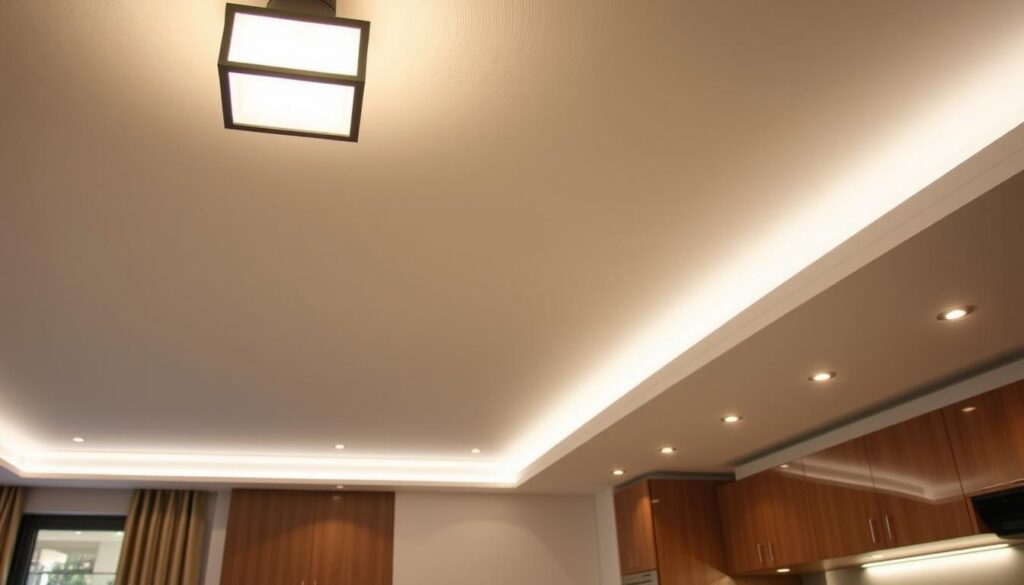
Setting Up Smart Switches
Setting up smart switches needs a bit more knowledge. You’ll replace your switches with smart ones. Always follow the manufacturer’s instructions and take safety precautions when working with electrical systems.
| Smart Switch Type | Installation Requirements | Key Features |
|---|---|---|
| Wi-Fi Enabled | Neutral wire required | Remote access, scheduling |
| Zigbee/Z-Wave | Hub required | Multi-device control, voice assistant integration |
Safety Considerations During Installation
Safety is key when installing smart lighting. Always follow safety protocols when working with electrical systems. This includes turning off the power at the circuit breaker or fuse box.
By following these steps and taking safety precautions, you can enjoy automated lighting. This will make your home more comfortable, convenient, and energy-efficient.
Configuring Your Smart Lighting System
Setting up your smart lighting system is key to its full use. A good setup makes your home look better and saves energy. It also makes life easier.
Downloading and Setting Up Apps
The first thing to do is download and set up the apps. Most systems have an app to control lights from afar. Just search for your brand’s app, download it, and follow the instructions.
Key Steps to Downloading and Setting Up the App:
- Search for your smart lighting brand’s app.
- Download and install the app.
- Create an account or log in if you already have one.
- Follow the in-app instructions to connect your smart lighting system.
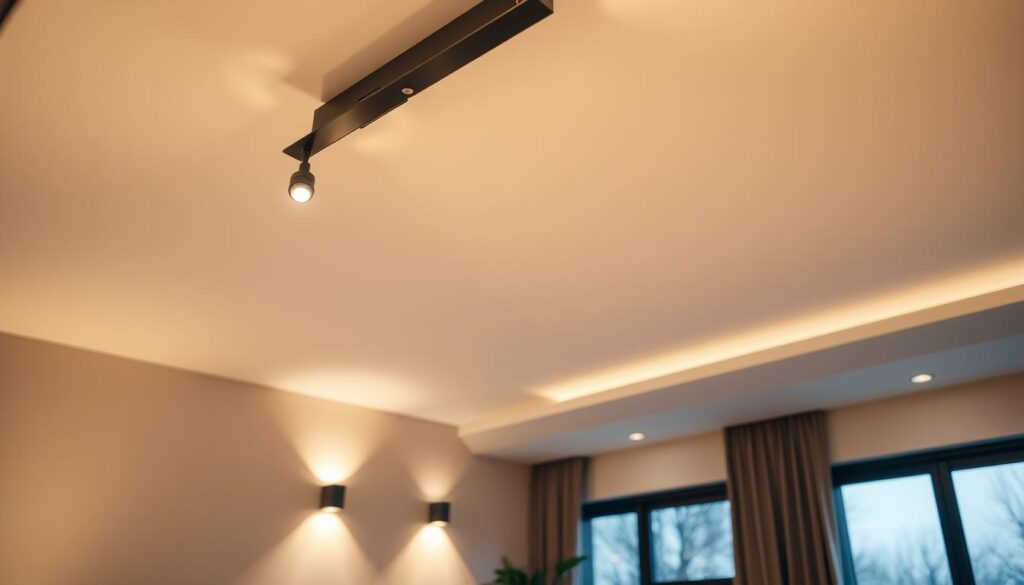
Creating Rooms and Zones
Once the app is ready, you can make rooms and zones. This lets you group lights and control them together. It makes managing your lights easier.
Benefits of Creating Rooms and Zones:
- Simplified control: Adjust multiple lights with a single command.
- Customized ambiance: Create different lighting scenes for various activities.
- Energy efficiency: Easily turn off lights in entire rooms or zones.
Establishing Basic Controls
After setting up rooms and zones, you can set basic controls. This includes adjusting brightness, color, and scheduling.
Basic Controls to Consider:
- Brightness adjustment.
- Color temperature control.
- Scheduling: Automate your lights to turn on/off at specific times.
Troubleshooting Initial Setup Issues
When setting up, you might run into problems. Issues like connectivity, app crashes, or lights not working are common.
Tips for Troubleshooting:
- Restart your router and smart lighting hub.
- Check for app updates.
- Ensure your lights are properly connected to the hub.
By following these steps and tips, you can set up your smart lighting system right. Enjoy the elegance and efficiency it brings to your home.
Creating Automated Lighting Scenes
Automated lighting scenes can change your home’s mood and function instantly. You can set up specific lighting setups for different times or events. This makes it easy to control your home’s atmosphere with little effort.
Morning and Evening Routines
Automated lighting scenes can help you start your day or relax in the evening. For example, a “Good Morning” scene can slowly brighten your room like a sunrise. An “Evening Relax” scene can dim the lights and change colors for a cozy feel.
Entertainment and Party Modes
Smart lighting can make your entertainment better. You can create a “Party” scene that changes colors with the music. For a dinner, a “Dinner Party” scene can set a warm, inviting light.
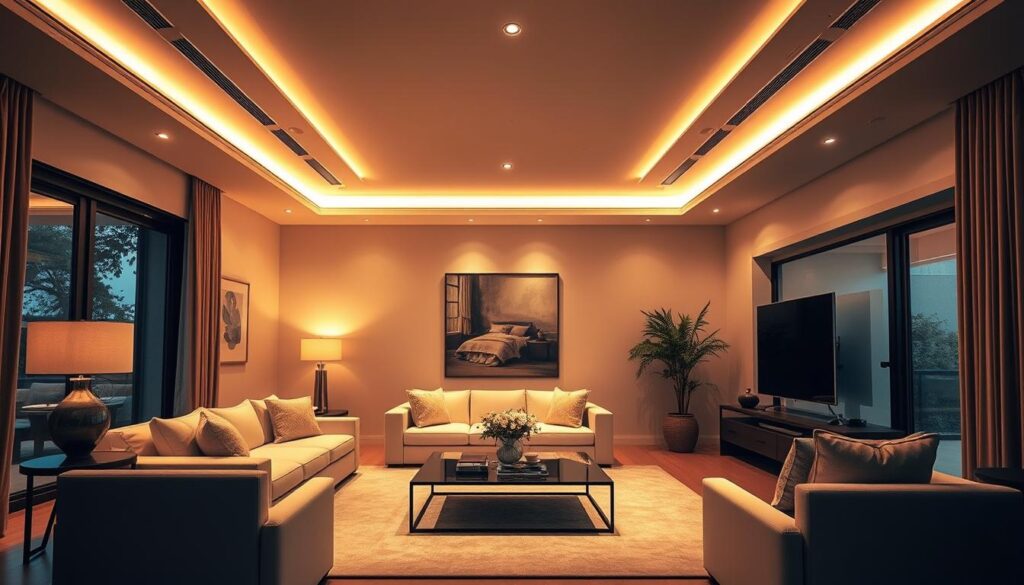
Away-from-Home Security Lighting
When you’re not home, automated lighting scenes can make it seem like you are. You can set a scene to turn lights on and off randomly. This can scare off intruders and give you peace of mind.
Seasonal Lighting Themes
You can change your home’s look with seasonal lighting themes. For holidays, set up a “Christmas” scene with festive lights. In summer, a “Summer Nights” scene can be cool and calming. This lets you easily match your lighting to the seasons and holidays.
Automated lighting scenes make your home more convenient, secure, and fun. They help with daily routines, entertainment, and security. With smart lighting, you can customize and control your home in many ways.
Voice Control and Smart Assistants
Imagine controlling your lights with just your voice – welcome to the world of smart lighting and voice assistants. Voice control has become a cornerstone of smart home technology. It offers unparalleled convenience and flexibility.
Setting Up Voice Commands
To start using voice control with your smart lighting, you’ll first need to set up voice commands with your preferred smart assistant. This involves linking your smart lighting system to the smart assistant’s platform, such as Amazon Alexa, Google Assistant, or Apple Siri.
The process typically involves opening the smart assistant’s app, searching for your smart lighting system’s skill or action, and enabling it. Once enabled, you can discover devices and assign them to rooms for easier control.
Alexa Voice Control Techniques
Alexa is one of the most popular smart assistants for voice control. To control your lights with Alexa, you can use simple commands like “Alexa, turn on the living room lights” or “Alexa, dim the bedroom lights to 50%.”
You can also create routines that involve multiple actions with a single command, such as “Alexa, goodnight,” which could turn off all lights, lock doors, and adjust the thermostat.
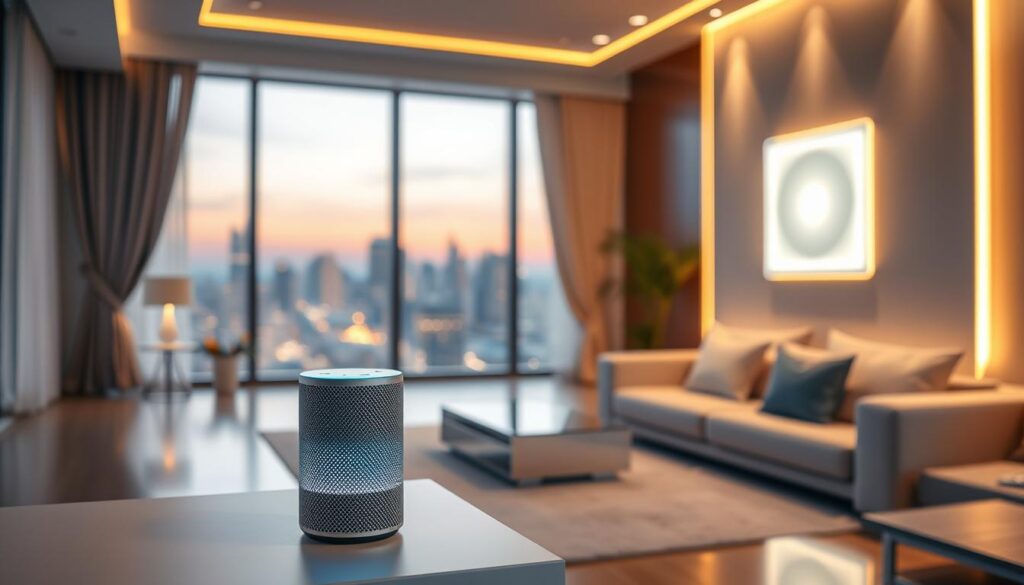
Google Assistant Light Control
Google Assistant offers another robust platform for voice control. With Google Assistant, you can control your smart lights using natural language commands, such as “Hey Google, turn on the kitchen lights” or “Hey Google, what’s the status of my living room lights?”
Google Assistant also integrates well with other Google services, making it a versatile choice for those already invested in the Google ecosystem.
Siri and HomeKit Voice Integration
For those using Apple devices, Siri and HomeKit provide a seamless voice control experience. By integrating your smart lights with HomeKit, you can control them using Siri voice commands, such as “Hey Siri, turn off the hallway lights.”
Siri also allows for the creation of custom shortcuts that can control multiple devices with a single voice command, making your smart home experience better.
By leveraging voice control with smart assistants, you can enjoy a more convenient, energy-efficient, and futuristic smart home lighting experience.
Integrating with Smart Home Ecosystems
Adding smart lighting to your smart home makes life easier and more efficient. You’ll see how well it works with your home’s systems.
Compatibility with Amazon Alexa
Amazon Alexa is a top choice for smart homes. It makes controlling your lights simple with voice commands. You can change brightness and colors with just your voice.
Key Benefits: Easy voice control, works with other Alexa devices, and lets you set up custom routines.
Working with Google Home
Google Home is another great option for smart lighting. You can use voice commands to control your lights. Plus, Google’s advanced features make things even better.
Key Features: Smooth voice control, connects with other Google devices, and supports complex routines.
Apple HomeKit Integration
If you’re an Apple fan, HomeKit is perfect. It keeps your smart devices, like lights, safe and easy to manage through the Home app.
Advantages: Secure data, simple setup, and Siri voice control.
Connecting with Samsung SmartThings
Samsung SmartThings is great for connecting many smart devices, including lights. It lets you set up complex routines and control devices from anywhere.
Key Benefits: Works with many devices, offers advanced automation, and has a central hub for control.
| Smart Home System | Key Features | Benefits |
|---|---|---|
| Amazon Alexa | Voice control, custom routines | Enhanced convenience, easy integration |
| Google Home | Voice control, advanced routines | Seamless integration, complex automation |
| Apple HomeKit | Secure integration, Siri voice control | Data security, streamlined experience |
| Samsung SmartThings | Wide device compatibility, advanced automation | Centralized control, versatile integration |
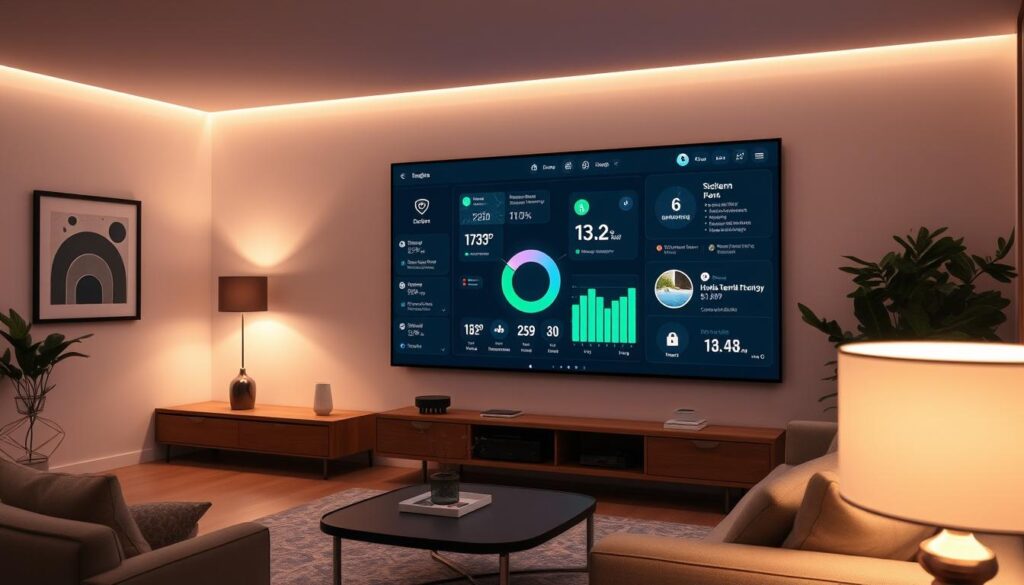
Connecting your smart lighting to these systems makes your home better. You can choose from Alexa, Google, Apple, or Samsung. Each offers something special for your smart home.
Energy Efficiency and Cost Savings
Smart lighting makes your home more sustainable and saves money. It uses energy wisely, cutting down on waste and bills.
Monitoring Energy Consumption
Smart lighting tracks energy use in real-time. Homeowners can see how much energy their lights use. They can spot inefficiencies and make changes.
Benefits of Monitoring Energy Consumption:
- Find energy-wasting devices and swap them for better ones.
- Learn how you use lights to set better schedules.
- Get alerts when bulbs need to be replaced.
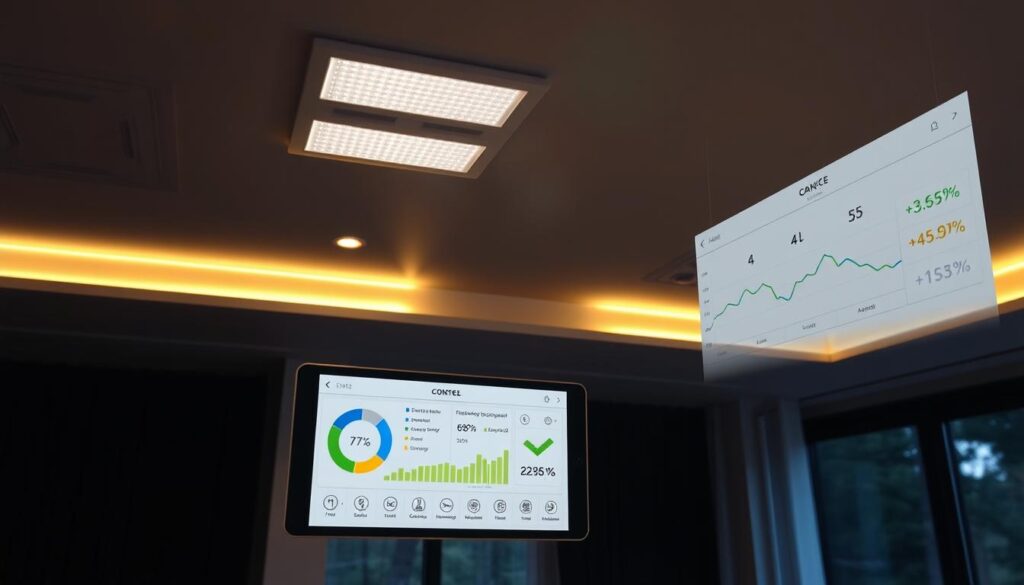
Scheduling for Optimal Efficiency
Scheduling is key in smart lighting. It lets you control your lights for better energy use. By setting times, you turn off lights when not in use.
| Scheduling Option | Description | Energy Saving |
|---|---|---|
| Automated Timers | Turn lights on/off at set times. | High |
| Scene Settings | Adjust lighting for different activities. | Medium to High |
| Presence Simulation | Mimic being home when you’re not. | Medium |
Long-term Financial Benefits
Smart lighting offers big financial gains. It might cost more upfront than regular lights. But, it saves a lot of energy over time. Plus, smart bulbs last longer, saving on replacements.
To save even more, link your smart lighting with other smart home devices. This makes your home fully automated and efficient.
Conclusion
Smart lighting is changing how we live, combining new light fixtures with smart tech for a better home.
Learning about smart lighting and picking the right products can make your home more comfortable and stylish. It also saves energy and money.
Adding smart lighting to your home makes it more than just a place to live. It becomes a space you can control easily with voice commands or apps.
Now, you know how to make your home smarter with lighting. Enjoy the perks of saving energy, cutting costs, and a more pleasant living space.
